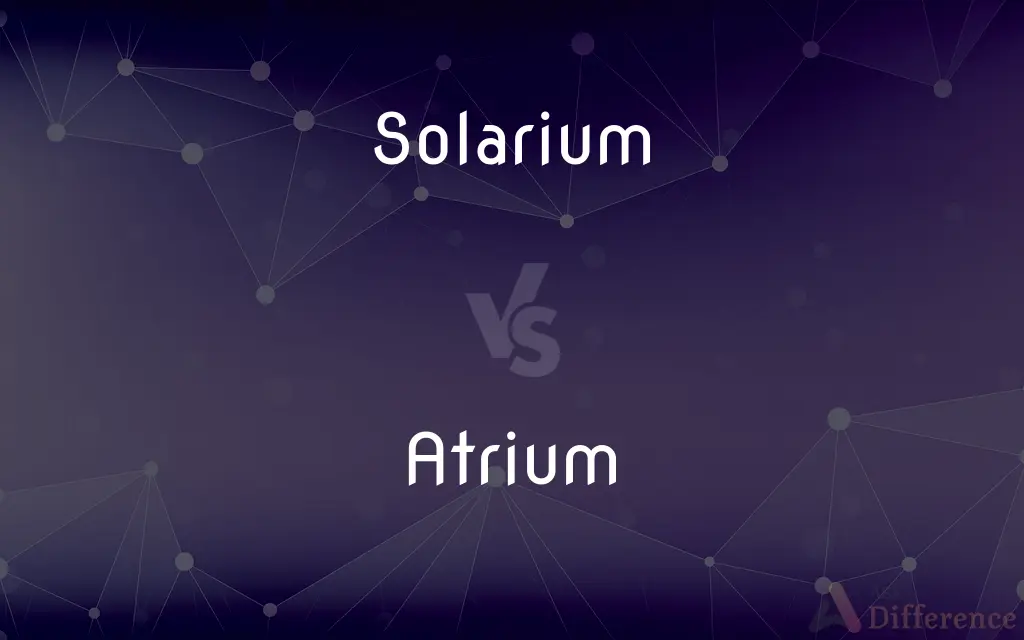Solarium vs. Atrium — What's the Difference?
Edited by Tayyaba Rehman — By Urooj Arif — Updated on April 2, 2024
A solarium is designed to allow abundant sunlight, often for relaxation or plant growth, whereas an atrium is a large open-air or skylight-covered space within a building.

Difference Between Solarium and Atrium
Table of Contents
ADVERTISEMENT
Key Differences
A solarium, often constructed with glass walls and roofing, is intended to provide a sun-filled environment for relaxation or plant growth. It maximizes sunlight exposure, making it ideal for colder climates where natural warmth and light are desired indoors. On the other hand, an atrium serves as a central space in buildings, characterized by its openness and often featuring a skylight or glass ceiling. Unlike solariums, atriums are not primarily focused on sun exposure but rather on creating an open, communal area that can serve multiple purposes, such as social gatherings or as a tranquil indoor garden space.
Solariums are typically added to residential homes as a sunroom or conservatory, where individuals can enjoy the sun without being outside. This makes them a perfect retreat during winter months. Conversely, atriums are more common in commercial or public buildings like malls, hotels, and offices, acting as a grand entrance or central gathering place that enhances the architectural appeal and spatial experience of the building.
In terms of functionality, solariums are specifically designed to trap heat through the greenhouse effect, providing a warm space that can support plant life or offer a cozy spot for homeowners. Atriums, however, may not always be designed with temperature control in mind; their primary function is to open up the interior of a building to natural light, creating a feeling of space and openness.
From an architectural standpoint, solariums require careful consideration regarding materials and orientation to effectively capture and retain heat. They often feature thermal glass and are positioned to receive maximum sunlight. Atriums, while they may also use extensive glasswork, focus more on the spatial layout, enhancing the building’s aesthetics and functionality by integrating indoor and outdoor elements.
While both solariums and atriums enhance a building's connection to the natural environment, their roles and features cater to different needs and preferences. A solarium is more of a private space designed for enjoyment of the sun's warmth and light, while an atrium is a public or semi-public space that serves as a dramatic focal point of a building, offering a spacious and light-filled environment for various activities.
ADVERTISEMENT
Comparison Chart
Primary Use
Sun exposure and relaxation
Central space within a building
Location
Attached to residential homes
Found in commercial or public buildings
Design Focus
Maximizing sunlight and warmth
Creating an open, communal area
Climate Control
Designed to trap heat
May not be designed with temperature control
Functionality
Private relaxation or plant growth space
Public or semi-public gathering space
Compare with Definitions
Solarium
A room designed to allow abundant sunlight, often used for relaxation or to cultivate plants.
The house's solarium, with its glass walls, offered a perfect spot for winter gardening.
Atrium
An open central court in ancient Roman homes, now in modern buildings.
The hotel’s atrium, with its towering palm trees, was breathtaking.
Solarium
A greenhouse attached to a residence for growing plants.
The Victorian solarium served as a conservatory, filled with exotic plants.
Atrium
A design element that creates an open and spacious environment within buildings.
The museum’s atrium, with its modern design, welcomed visitors into a spacious interior.
Solarium
A room in a house, similar to a conservatory, used to capture and enjoy sunlight.
They converted their patio into a solarium to enjoy the sun year-round.
Atrium
A space designed to increase natural lighting within buildings.
The atrium’s glass ceiling flooded the library with daylight, making it a warm and inviting space.
Solarium
A space utilized for growing plants that require ample sunlight.
The solarium’s controlled environment was perfect for cultivating tropical plants.
Atrium
A large, open space in a building, often with a glass roof.
The shopping mall’s atrium was filled with natural light, enhancing the shopping experience.
Solarium
A designated area in a home to enjoy natural light and warmth.
Their solarium, furnished with comfortable chairs, was the ideal relaxation space.
Atrium
A communal area within a building used for gatherings and events.
The atrium in the office building served as a common area for employees to relax and interact.
Solarium
A room, gallery, or glassed-in porch exposed to the sun.
Atrium
An open-roofed entrance hall or central court in an ancient Roman house.
Solarium
A room, rooftop, balcony, or terrace, used for its abundant sunlight (especially) when used as a medical treatment.
Atrium
A usually skylit central area, often containing plants, in some modern buildings, especially of a public or commercial nature.
Solarium
Synonym of tanning salon, a room or business used for its sunlamps or tanning beds.
Atrium
The open area in the center of an ancient Roman house.
Solarium
(archaic) sundial.
Atrium
The forecourt of a building, such as an early Christian church, enclosed on three or four sides with porticoes.
Solarium
An apartment freely exposed to the sun; anciently, an apartment or inclosure on the roof of a house; in modern times, an apartment in a hospital, used as a resort for convalescents.
Atrium
(architecture) A central room or space in ancient Roman homes, open to the sky in the middle; a similar space in other buildings.
Solarium
Any one of several species of handsome marine spiral shells of the genus Solarium and allied genera. The shell is conical, and usually has a large, deep umbilicus exposing the upper whorls. Called also perspective shell.
Atrium
(architecture) A square hall lit by daylight from above, into which rooms open at one or more levels.
Solarium
A room enclosed largely with glass and affording exposure to the sun
Atrium
(anatomy) A cavity, entrance, or passage.
An atrium of the infundibula of the lungs
Atrium
(biology) Any enclosed body cavity or chamber.
Atrium
(anatomy) A microscopic air sac within a pulmonary alveolus.
Atrium
A square hall lighted from above, into which rooms open at one or more levels.
Atrium
The main part of either auricle of the heart as distinct from the auricular appendix. Also, the whole articular portion of the heart.
Atrium
A cavity in ascidians into which the intestine and generative ducts open, and which also receives the water from the gills. See Ascidioidea.
Atrium
A cavity, entrance, or passage; as, the atrium, or atrial cavity, in the body wall of the amphioxus; an atrium of the infundibula of the lungs, etc.
Atrium
Any chamber that is connected to other chambers or passageways (especially one of the two upper chambers of the heart)
Atrium
The central area in a building; open to the sky
Common Curiosities
Can a solarium increase a home’s value?
Yes, a well-designed solarium can add aesthetic and functional value to a home.
Are solariums energy-efficient?
Solariums can be energy-efficient if designed with thermal glass and proper orientation but may require additional heating in colder climates.
Can an atrium serve as a greenhouse?
While an atrium can house plants, it is primarily designed as a communal space rather than for controlled plant growth.
Is an atrium considered indoor or outdoor space?
An atrium is considered an indoor space, even if it incorporates outdoor elements like plants or water features.
What makes an atrium different from a lobby?
An atrium is a larger, open space that may span multiple floors, while a lobby is typically the entrance area at the main floor of a building.
Do solariums need special glass?
Yes, solariums often use thermal or insulated glass to maintain temperature and maximize energy efficiency.
Are there any specific maintenance challenges for solariums?
Maintenance can include cleaning glass surfaces and managing temperature and humidity levels to protect plants and interior comfort.
What is the primary purpose of a solarium?
To provide a space that maximizes sunlight exposure for relaxation or plant growth.
How do atriums enhance a building’s design?
Atriums create a sense of openness and natural light, making the interior more inviting and aesthetically pleasing.
Can solariums be used year-round?
Yes, with proper heating and cooling systems, solariums can be enjoyed throughout the year.
Why are atriums popular in commercial buildings?
They enhance the aesthetic appeal and functionality of the space, making buildings more attractive to visitors and occupants.
What considerations are important when designing a solarium?
Orientation, glass type, ventilation, and heating/cooling systems are crucial for creating a comfortable and functional solarium.
How does a solarium differ from a patio?
A solarium is enclosed with glass and can be used in all weather, while a patio is an outdoor space.
What role do atriums play in modern architecture?
Atriums serve as central gathering spaces that enhance natural lighting and the spatial quality of buildings.
What is the key architectural feature of an atrium?
The key feature is its open space, often extending through several floors and topped with a skylight.
Share Your Discovery

Previous Comparison
Salt vs. Sault
Next Comparison
Prose vs. NarrativeAuthor Spotlight
Written by
Urooj ArifUrooj is a skilled content writer at Ask Difference, known for her exceptional ability to simplify complex topics into engaging and informative content. With a passion for research and a flair for clear, concise writing, she consistently delivers articles that resonate with our diverse audience.
Edited by
Tayyaba RehmanTayyaba Rehman is a distinguished writer, currently serving as a primary contributor to askdifference.com. As a researcher in semantics and etymology, Tayyaba's passion for the complexity of languages and their distinctions has found a perfect home on the platform. Tayyaba delves into the intricacies of language, distinguishing between commonly confused words and phrases, thereby providing clarity for readers worldwide.














































